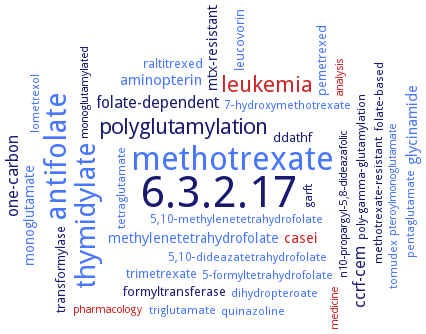Please wait a moment until all data is loaded. This message will disappear when all data is loaded.
Please wait a moment until the data is sorted. This message will disappear when the data is sorted.
expressed in AuxB1 cells
-
expressed in Escherichia coli strain BL21
expressed in Escherichia coli strain BL21 (DELTADE3)
-
expressed in Mus musculus
-
expression in Escherichia coli
expression in Escherichia coli and Saccharomyces cerevisiae
-
expression in Escherichia coli BL21 cells
-
expression in Escherichia coli FPGS deficient strain and in CHO AUXB1 cells
-
expression in Escherichia coli strain BL21
expression in Saccharomyces cerevisiae FPGS deficient strains
-
expression in Sf9 cells
-
expression in Sf9 insect cells
expression of the liver or L1210 isoforms in Sf9 insect cells
-
expression of wild type and mutant enzymes in AUXB1 cell line, which does not express measurable enzyme activity and is auxotrophic for the products of folate metabolism
-
expression of wild type and mutant enzymes in Sf9 insect cells
-
FPGS enzyme genotyping, overview
gene fpgs, determination of genotypes and mRNA expression levels in 190 female and male unrelated healthy Japanese people, quantitative real-time PCR enzyme expression analysis reveals significant differences in sex-specific mRNA expression, detailed overview
gene FPGS, DNA and amino acid sequence analysis, promoter determination and analysis, overview, recombinnat expression in murine knockout cell line AUXB1
gene fpgS, DNA and amino acid sequence determination and analysis
gene FPGS, DNA and amino acid sequence determination and analysis of splicing variants, quantitative RT- and real-time-PCR analyses of FPGS enzyme expression and splicing patterns. FPGS splicing alterations are abundant in blasts of acute lymphoblastic leukemia (ALL) patients, overview
-
gene FPGS, gene-specific promoter CpG DNA methylation analysis and global DNA methylation analysis, recombinant FPGS overexpression in HCT-116 and MDA-MB-435 cells, quantitative RT-PCR enzyme expression analysis
-
gene FPGS, genotyping in different human populations
-
gene FPGS, genotyping of 134 children suffering acute lymphoblastic leukemia (ALL), overview
gene FPGS, genotyping of FPGS rs1544105 polymorphism in 57 ALL patients and 31 age and sex-matched children
-
gene FPGS, sequence comparisons, genotyping, sequence of FPGS cDNAs from hamster cells auxotrophic for thymidine, purine, and glycine, FPGS cytosolic isoform expression in CHO, AUXB1, and AUXB1 cells stably transfected with cDNA for fpgs under a viral promoter, the cFPGStet cell line is made by transfecting the fpgs cDNA that produces only cytosolic FPGS protein under doxycycline control, cytosolic folates are observed in both cFPGStet and mFPGStet cells in the presence of doxycyclin
gene FPGS, sequence comparisons, genotyping, sequence of FPGS cDNAs from hamster cells auxotrophic for thymidine, purine, and glycine, FPGS mitochondrial isoform expression in CHO, AUXB1, and AUXB1 cells stably transfected with cDNA for fpgs under a viral promoter. Enzyme expression in the mutant cells can complement the mutants which no longer require supplementation with purines, thymidine, or glycine for survival, the mFPGStet cell line is made by transfecting the fpgs cDNA that produces only mitochondrial FPGS protein under doxycycline control, cytosolic folates are observed in both cFPGStet and mFPGStet cells in the presence of doxycyclin
gene fpgs, the mouse uses two promoters: P2, akin to the human promoter, at low levels in most tissues, and P1, an upstream promoter used extensively in liver and kidney. In mice, 2 additional exons (A1a and A1b), 10 kb upstream of the 15 exons homologous to those of the human gene, are used in place of exon 1 when an associated promoter (P1) is activated. The mouse fpgs gene transcribes strongly and predominantly from the P1 promoter in liver and kidney, the 2 major folate storage organs, but its transcription initiates exclusively from the proximal promoter (P2) in all other murine tissues, tumors, and cell lines, indicating liver- and kidney-specific transcription factors for P1 promoter usage. In mouse P2, the behavior and distribution of transcription factor binding sites are very similar to those of the human promoter. Two contiguous HindIII genomic DNA fragments containing the mouse fpgs promoters are cloned previously from a mouse 129/sv bacterial artificial chromosome (BAC) library including the promoter P1 or P2 sequences, respectively, P1 is cloned into the P1-A1aA1b targeting vector for generation of embryonic stem (ES) cells with P1 conditional- or complete-KO fpgs allele. Determination of the stability and translation efficiency of the proteins made from P1 and P2 promoters
gene GRMZM2G393334, DNA and amino acid sequence determination and analysis, expression of the enzyme in FPGS-deficient met7 yeast rescues the yeast mutant phenotype
HCT-116 cells stable transfected with the sense or antisense FPGS cDNA. Compared with cells expressing endogenous FPGS, those overexpressing FPGS have significantly faster growth rates and higher concentrations of total folate and long-chain folate polyglutamates while antisense FPGS inhibition produces opposite results. FPGS overexpression significantly enhances, whereas FPGS inhibition decreases chemosensitivity to 5-fluorouracil. No significant difference in chemosensitivity to methotrexate is observed
-
overexpression in Escherichia coli
the folC gene from Escherichia coli is cloned into plasmid pET29. The resulting plasmid, pVRC1432, is transferred into the Escherichia coli BL21 strain
-
expression in Escherichia coli

-
expression in Escherichia coli
-
expression in Escherichia coli
expression in Escherichia coli
expression in Escherichia coli
-
expression in Escherichia coli strain BL21

-
expression in Escherichia coli strain BL21
-
expression in Sf9 insect cells

-
expression in Sf9 insect cells
-
overexpression in Escherichia coli

-
overexpression in Escherichia coli
-




 results (
results ( results (
results ( top
top





